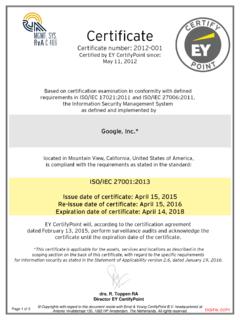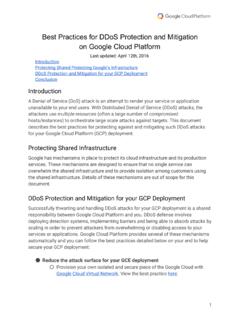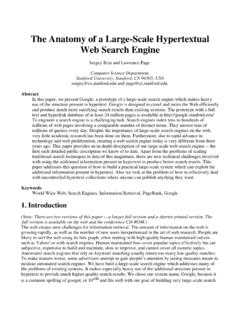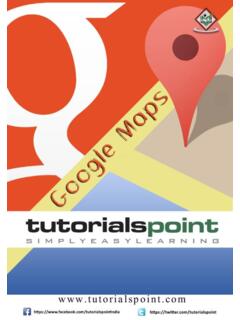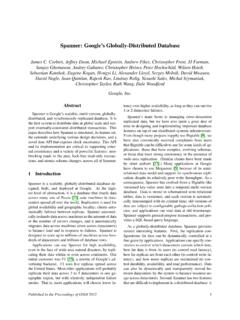Transcription of An Inside Look at Google BigQuery
1 Table of ContentsAbstract ..2 How Google Handles Big Data Daily Operations ..2 BigQuery : Externalization of Dremel ..2 Dremel Can Scan 35 Billion Rows Without an ..3 Index in Tens of Seconds Columnar Storage and Tree Architecture of Dremel ..3 Columnar Storage ..4 Tree Architecture ..4 Dremel: Key to Run Business at Google Speed ..5 And what is BigQuery ? ..5 BigQuery versus MapReduce ..6 Comparing BigQuery and MapReduce ..6 MapReduce Limitations ..7 BigQuery and MapReduce Comparison ..8 Data Warehouse Solutions and Appliances for OLAP/BI ..10 Relational OLAP (ROLAP) ..10 Multidimensional OLAP (MOLAP) ..10 Full-scan Speed Is the Solution..10 BigQuery s Unique Abilities ..11 Cloud-Powered Massively Parallel Query Service ..11 Why Use the Google Cloud Platform?
2 12 Conclusion ..12 References ..12 Acknowledgements ..12An Inside Look at Google BigQueryWhite Paper | BigQueryAn Inside Look at Google BigQueryby Kazunori Sato, Solutions Architect, Cloud Solutions team AbstractThis white paper introduces Google BigQuery , a fully-managed and cloud-based interactive query service for massive datasets. BigQuery is the external implementation of one of the company s core technologies whose code name is Dremel. This paper discusses the uniqueness of the technology as a cloud-enabled massively parallel query engine, the differences between BigQuery and Dremel, and how BigQuery compares with other technologies such as MapReduce/Hadoop and existing data warehouse Google Handles Big Data Daily OperationsGoogle handles Big Data every second of every day to provide services like Search, YouTube, Gmail and Google Docs.
3 Can you imagine how Google handles this kind of Big Data during daily operations? Just to give you an idea, consider the following scenarios: What if a director suddenly asks, Hey, can you give me yesterday s number of impressions for AdWords display ads but only in the Tokyo region? . Or, Can you quickly draw a graph of AdWords traffic trends for this particular region and for this specific time interval in a day? What kind of technology would you use to scan Big Data at blazing speeds so you could answer the director s questions within a few minutes? If you worked at Google , the answer would be is a query service that allows you to run SQL-like queries against very, very large data sets and get accurate results in mere seconds. You just need a basic knowledge of SQL to query extremely large datasets in an ad hoc manner.
4 At Google , engineers and non-engineers alike, including analysts, tech support staff and technical account managers, use this technology many times a : Externalization of DremelBefore diving into Dremel, we should briefly clarify the difference between Dremel and Google BigQuery . BigQuery is the public implementation of Dremel that was recently launched to general availability. BigQuery provides the core set of features available in Dremel to third party developers. It does so via a REST API, a command line interface, a Web UI, access control and more, while maintaining the unprecedented query performance of this paper, we will be discussing Dremel s underlying technology, and then compare its externalization, BigQuery , with other existing technologies like MapReduce, Hadoop and Data Warehouse Can Scan 35 Billion Rows Without an Index in Tens of Seconds Dremel, the cloud-powered massively parallel query service, shares Google s infrastructure, so it can parallelize each query and run it on tens of thousands of servers simultaneously.
5 You can see the economies of scale inherent in Dremel. Google s Cloud Platform makes it possible to realize super fast query performance at very attractive cost-to-value ratio. In addition, there s no capital expenditure required on the user s part for the supporting infrastructure. As an example, let s consider the following SQL query, which requests the Wikipedia content titles that includes numeric characters in it:select count(*) from where REGEXP_MATCH (title, [0-9]* ) AND wp_namespace = 0;Notice the following: This wikipedia table holds all the change history records on Wikipedia s article content and consists of 314 millions of rows that s The expression REGEXP_MATCH(title, [0-9]+ ) means it executes a regular expression matching on title of each change history record to extract rows that includes numeric characters in its title ( List of top 500 Major League Baseball home run hitters or United States presidential election, 2008 ).
6 Most importantly, note that there was no index or any pre-aggregated values for this table prepared in advance. When you issue the query above on BigQuery , you get the following results with an interactive response time of 10 seconds in most ,163,387 Here, you can see that there are about 223 million rows of Wikipedia change histories that have numeric characters in the title. This result was aggregated by actually applying regular expression matching on all the rows in the table as a full scan. Dremel can even execute a complex regular expression text matching on a huge logging table that consists of about 35 billion rows and 20 TB, in merely tens of seconds. This is the power of Dremel; it has super high scalability and most of the time it returns results within seconds or tens of seconds no matter how big the queried dataset is.
7 Columnar Storage and Tree Architecture of DremelWhy Dremel can be so drastically fast as the examples show? The answer can be found in two core technologies which gives Dremel this unprecedented performance: 1. Columnar Storage. Data is stored in a columnar storage fashion which makes possible to achieve very high compression ratio and scan Tree Architecture is used for dispatching queries and aggregating results across thousands of machines in a few StorageDremel stores data in its columnar storage, which means it separates a record into column values and stores each value on different storage volume, whereas traditional databases normally store the whole record on one technique is called Columnar storage and has been used in traditional data warehouse solutions.
8 Columnar storage has the following advantages: Traffic minimization. Only required column values on each query are scanned and transferred on query execution. For example, a query SELECT top(title) FROM foo would access the title column values only. In case of the Wikipedia table example, the query would scan only out of Higher compression ratio. One study3 reports that columnar storage can achieve a compression ratio of 1:10, whereas ordinary row-based storage can compress at roughly 1:3. Because each column would have similar values, especially if the cardinality of the column (variation of possible column values) is low, it s easier to gain higher compression ratios than row-based storage has the disadvantage of not working efficiently when updating existing records.
9 In the case of Dremel, it simply doesn t support any update operations. Thus the technique has been used mainly in read-only OLAP/BI type of the technology has been popular as a data warehouse database design, Dremel is one of the first implementations of a columnar storage-based analytics system that harnesses the computing power of many thousands of servers and is delivered as a cloud service. Tree ArchitectureOne of the challenges Google had in designing Dremel was how to dispatch queries and collect results across tens of thousands of machines in a matter of seconds. The challenge was resolved by using the Tree architecture. The architecture forms a massively parallel distributed tree for pushing down a query to the tree and then aggregating the results from the leaves at a blazingly fast storage of Dremel5By leveraging this architecture, Google was able to implement the distributed design for Dremel and realize the vision of the massively parallel columnar-based database on the cloud platform.
10 These previous technologies are the reason of the breakthrough of Dremel s unparalleled performance and cost technical details on columnar storage and tree architecture of Dremel, refer to the Dremel paper1 .Dremel: Key to Run Business at Google Speed Google has been using Dremel in production since 2006 and has been continuously evolving it for the last 6 years. Examples of applications include1: Analysis of crawled web documents Tracking install data for applications in the Android Market Crash reporting for Google products OCR results from Google Books Spam analysis Debugging of map tiles on Google Maps Tablet migrations in managed Bigtable instances Results of tests run on Google s distributed build system Disk I/O statistics for hundreds of thousands of disks Resource monitoring for jobs run in Google s data centers Symbols and dependencies in Google s codebaseAs you can see from the list, Dremel has been an important core technology for Google , enabling virtually every part of the company to operate at Google speed with Big what is BigQuery ?
